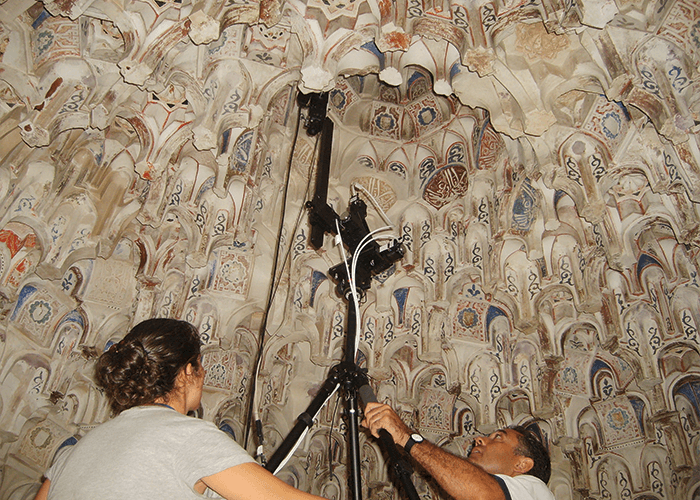
Raman spectroscopy is highly prized in the field of cultural heritage because it allows non-destructive chemical analysis of artifacts. Portability further expands the application potential by allowing real-time, non-invasive field studies and by eliminating the need to take samples. A collaborative group from the University of Jaen and the Conservation Department of the Alhambra and Generalife Council, both in Spain, recently launched a study of decorations in the Alhambra, a Moorish palace and UNESCO World Heritage Site (1). The team used a combination of analytical techniques that allowed most of the studies to be performed in situ. For example, portable Raman was used to detect the pigments and elucidate the techniques employed in the creation of the plasterwork – and to assess any potential conservation problems (2).
“Analytical techniques can provide the answers to many queries regarding the conservation state of assets under study or rehabilitation,” says María José Ayora Cañada (Department of Physical and Analytical Chemistry, University of Jaen). “The characterization of decay compounds and the understanding of the degradation pathways – in many cases caused by chemical reactions between the original compounds and chemicals present in the environment – are crucial for the design of appropriate strategies of preventive conservation and intervention.” Ayora Cañada notes that, for the past few decades in the field of cultural heritage, interest has been focused on the development of non-invasive or non-destructive analytical techniques. “When dealing with artifacts, most of the challenges are around sample preparation, which is in many cases complex and labor intensive. In addition to preserving the artwork with a non-invasive study, the on-site investigation gives a more representative knowledge of the art objects, because the measurements are not limited to the samples that can be taken,” she adds. But in-situ measurements pose unique challenges – especially when working on top of scaffolding. “The vibrations made it difficult to maintain the laser beam in focus in prolonged measurements,” says Ayora Cañada. “Daylight was a big problem; the Raman effect is very weak and background radiation from sunlight interfered with the spectra. The problem was partially solved by attaching a cover of dark foam to prevent the sunlight from reaching the objective aperture.”
The team took to the lab to make other measurements that were simply not possible in the field, including analysis using a more sensitive Raman instrument. “Scanning electron microscopy equipped with energy dispersive spectroscopy (SEM-EDS) was also used to study the morphology and elemental composition of the samples – and to identify layers of different metals in gilded decorations,” says Ayora Cañada. “And we used Fourier transform infrared (FTIR) microscopy to gain information about the organic materials employed as binders.” Ayora Cañada notes the need for a collaborative effort when it comes to protecting our heritage: “Conservators and restorers who wish to conserve cultural assets need to work in cooperation with analytical scientists – the professionals who can study the materials and the way those materials age in a given environment.”
References
- P Arjonilla et al., Appl Phys A, 122,1014 (2016). A Dominguez-Vidal et al., J Raman Spectrosc, 45, 1006-1012 (2014).




